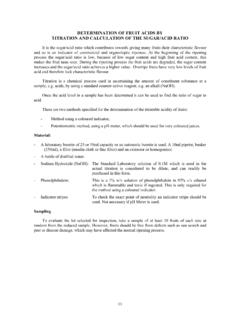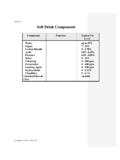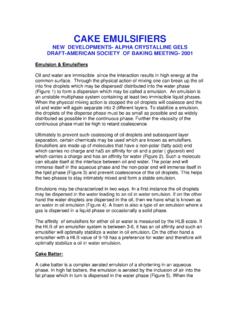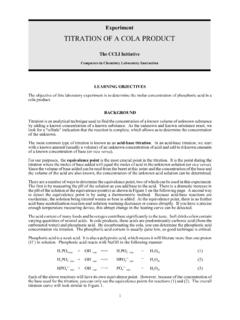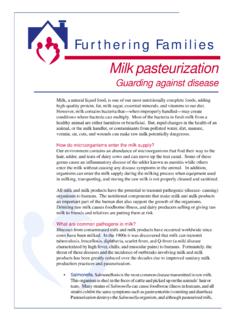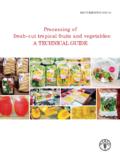Transcription of Sucrose esters, not a ‘sweet’ solution.
1 Sucrose esters , not a sweet ' solution. By: Bianca van Ingen, Managing Director Sisterna Contents 1. Introduction 2. Synopsis 3. Physical Chemical details 4. Usage in bakery applications 5. Usage in sugar (or sugar free) confections 6. Usage in dairy and desserts applications 7. Usage in sauces and emulsion 8. Regulatory status US. 9. Contact details 1) Introduction Sucrose esters of fatty acids, commonly known as Sucrose esters , and Sucrose oligo esters are a relatively new extension to the line of emulsifiers available for the American food market. Being based on Sucrose and edible fatty acids, Sucrose esters are a unique range of high quality, non- ionic emulsifiers. They are obtained by esterifying one or more of the (primary) hydroxyl groups of the Sucrose molecule with methyl fatty acids.
2 By varying the degree of esterification of the Sucrose molecule it is possible to obtain emulsifiers with HLB values ranging from 1 up to 16 for the high mono- esters . Sucrose esters can be used in a wide range of food applications. They are mostly used in bakery, confectionery, desserts and special emulsions. This white paper presents more detailed physical and chemical information as well as regulatory information about Sucrose esters and Sucrose oligo esters . 2) Synopsis Sucrose esters are classified as emulsifiers, besides emulsification they have additional functionalities for which they are often used. Other functions are starch interaction, protein interaction, sugar crystallisation and aeration.
3 These functions can affect production and the quality of the end product. The freshness of baked products, the flavour outcome in ice cream or chocolate mousse and the accelerated production of panned candy and soft candy are some examples. High mono esters based on stearate (Sisterna code SP70) expose most of the above mentioned functions and is often the first choice of food manufacturers. 3) Physical-, chemical details Chemical structure: In fig. 01 the chemical structure of Sucrose esters is given, R being the alkyl group of the fatty acid. The fatty acids react with one or more (primary) hydroxyl groups of Sucrose to form mono-, di- or tri- esters . Fig. 01 Chemical structure of a Sucrose molecule.
4 Identification: Sucrose esters and Sucrose oligo esters are normally identified by the source of fatty acids, containing either mostly palmitic or mostly stearic fatty acids (coded with P or S) and the mono-ester content or the HLB-value. The mono-ester content determines the HLB-value so usually either one is chosen. The coding of Sisterna products is based on: PS', for palmitic esters ;. SP', for stearic esters ;. 01-10-30-50-70-75', percentage of mono-ester in the ingredient. Sucrose esters differ from oligo esters in their ratio of mono, di, tri and higher esters . But are easy to recognize from their mono-ester content: Sucrose esters : mono-ester 30%, Sisterna codes are Sisterna PS750, SP70, SP50 and SP30.
5 Sucrose oligo esters : mono-ester <30%, Sisterna codes are Sisterna SP10 and SP01 (and also F20W)'. Stability: Sucrose (oligo) esters melt at temperatures between 40 C and 60 C, depending on the degree of esterification. Heating to temperatures up to 185 C can be done without any harmful effects on the performance. However, at temperatures higher than 140 C some colour formation can occur due to caramellisation of traces of free Sucrose present in the product. They are stable at pH values between 4 and 8. At pH values higher than 8, saponification of the ester bond may occur, while under acid conditions inversion of the Sucrose moiety is possible. Acid aggregation may occur at very low pH and high salt concentration.
6 Solubility: Sucrose esters are more easily dissolved in water and do not dissolve in oil. Sucrose oligo esters do not dissolve in water and dissolve better in oil. When the oil or water phase is heated to 60- 80 C the solubility improves. 4) Usage in bakery applications Sucrose esters of fatty acids are used in the main areas of baked goods such as (reduced fat) high ratio and pound cakes, sponge cakes, (low fat) biscuits and frozen dough. The functionalities of Sucrose esters in baked goods, besides their emulsifying properties, can be divided into two main areas: 1) Protein interaction: The chemical structure of Sucrose esters enables them to interact with the proteins present in flour, by means of hydrophilic and/or hydrophobic bindings.
7 See Fig 6. for an impression of the binding of Sucrose esters with the amino acids of a protein molecule. The result is a more flexible gluten network, which is better able to withstand the mechanical forces applied during intensive kneading, ensuring maximum gas retention. 2) Starch interaction The non-ionic character of Sucrose esters enables them to complex readily and effectively with amylose, present in flour. It is assumed that, like other emulsifiers, the fatty acid chain is trapped within the helical conformation of the amylase molecule. The resulting complex delays starch gelatinization and starch retrogradation. A soft crumb structure, large Sucrose esters in helical' amylase. volume and extended shelf life are the result.
8 Advantages of Sucrose esters in baked products: increased mixing tolerance of dough or batter high volume improved crumb softness improved shelf life improved freeze-thaw stability Page 6/11. 5) Usage in sugar (or sugar free) confections Sucrose esters are used in soft grained confection such as fudges, toffee's, fondants and chewies. Other application area's are cereal bars and panned confectionery. Two functionalities play a primary role in sugar confectionery. 1) Controlled sugar crystallisation Sucrose esters affect sugar crystallisation and sugar crystal stability. By adding Sucrose esters to a sugar solution the lower limit of the metastable region (Fig 3) will be at a lower temperature.
9 By increasing the metastable region or super saturation curve' many more nuclei will be formed. On these nuclei the sugar will crystallise. The more nuclei to begin with the more crystals will be created and the smaller the resulting average crystal size. Crystallisation will also be much quicker when there are more nuclei available on which to crystallise. Fig 03: Metastable region of a sugar solution at various temperatures and Brix values. A laser beam is sent through a hot sugar solution. When the solution cools down sugar crystals are formed. The solution becomes opaque and the laser beam is dispersed. This is detected by a light sensitive cell. The temperature at which this happens is the lower limit.
10 When reheated the crystals are dissolved again and the beam is not dispersed anymore. This temperature is the upper limit. The temperature range between upper and lower limit is called the metastable region. Page 7/11. 2) Emulsification Candy recipes often contain fat to carry the flavour and create a specific mouthfeel. Sucrose esters with a high HLB-value (high mono-ester content) are very strong oil-in-water emulsifiers and will disperse the fat thoroughly in the candy. This will prevent fat oozing from the candy and staining the paper wrapping additionally it prevents quality issues such as rancidity. In Fig 4, you can find the most commonly used emulsifiers and an indication of their HLB value.

